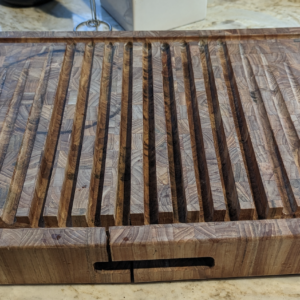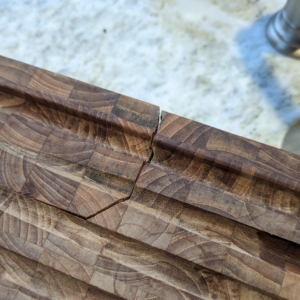How to prevent my drying rack from splitting
Hello
Hoping to get some advice here. I was sick of having an ugly drying rack on our kitchen counter and decided to built a wooden one I would be proud of looking at. Two years ago, I made my first one using a cutting board and it split within a few weeks.
I decided to plan better:I bought the thickest end grain butcher block I could find, made of teak so it would be dense and water-resistant. I used my router to build angled groves to evacuate the water, and made to sure to spread bee wax on it on a bi-weekly basis.
Unfortunately, 6 months later, the board split again (see pics). I know water isn’t the friend of a wooden board, but there’s got to be a way to prevent my rack from splitting.
Any advice?
Thanks

















Replies
This is what happens when wood gets soaked and dries, over and over and over again. Honestly, I wouldn't keep trying.
Holding the water is a bad idea. If you try again angle your grooves so the water drains off the board into the sink. I would not use end grain and I would minimize the numer of cross grain cuts.
You are working against the nature of wood here, which makes it difficult to achieve success. Have you thought about why the rack is splitting? The fact that it is splitting at the edges implies that the center is being wetter (and more swollen) than the edges, which try to stay smaller (being drier.) Something has to give, and the wood cracks.
What to do?
First, don't use endgrain, as it is much more porous than flat grain, and any water that gets in will go deeper quicker.
If you edge glue boards together, make sure the joints are slightly "sprung", i.e., slightly concave, so that there is natural extra pressure on the ends of the joints.
Use a much more waterproof finish; beeswax is not that great. The finish needs to be a penetrating one, preferably one that doesn't harden by solvent evaporation. I would try some sort of epoxy-like 2 part finish. Make sure you get good penetration on all surfaces, including the bottom and especially any endgrain. A surface finish won't provide enough protection over time, as any crack that develops will allow water thru, which will spread and not be able to get back out the crack.
And be aware that even this might not work over the long run; it just has a better chance.
That crack seems to me to be the result of glue failure at a joint. Water seeped in causing more expansion and caused that sideways crack where the glue was holding. Teak should be able to withstand a great deal of water contact ,however it is difficult to glue do to the natural oiliness of the wood. Oily hardwoods like that I wipe with lacquer thinner before gluing and still always cross my fingers when I do it. What glue to use? On exterior or going to get wet stuff my old standby is resorcinal or West System epoxy. These products have been around a long time and have a proven track record. The idea of using a glue that gets mixed fresh before using as opposed to something that comes straight out of bottle sits well with me so I tend to use it. Resorcinal leaves purple lines that to me are unpleasing in some cases. The technology of woodglues changes and there are probably other glues that would work but having had success with something I can't see any reason to change. I would not use a polyurethane glue such as gorilla glue,if you have anything less than a perfect joint it will be the weakest joint imaginable.
As to a finish I would probably use a penetrating oil....like teak oil and pure teak oil at that. The key word on any product is " finish " which means it is some kind of polymerized proprietary formula and may or may not have much or even any teak oil present. The other possibility with teak is no finish at all. Teak is used on boat decks with great effect and is often never finished,less slippery that way. Turns a dull gray however.
The tray under my dish drainer says "Rubbermaid" but the principles are the same I would think. It's canted so the water drains off into the sink. Water always finds a way underneath anyway - capillary attraction- and it has ribs that keep it elevated off of the countertop so that it will dry to some extent and hopefully not develop mold. Since wood expands and contracts I would attempt to equalize things by grooving the bottom as well,similar to the back cut they do with flooring and maybe put some kind of feet on so that it does not sit directly onto the counter.
Many things are made of wood that come in frequent contact with water ..boats,barrels and probably were never completely successful on a first try but developed over many attempts! Good luck!
Wood staying wet all the time isn't much of a problem. Boats, barrels, piers. Wet and drying is what causes issues. Old time sailing ships would either tow their boats behind them, keeping them wet, or fill them with water on deck.
Having sailed ,the dingy towed behind was more of a safety issue. If you go overboard it was a second chance! Also, hauling in and out and storing a dingy is a PIA and if your using it a lot, like in coastal areas, its just handier to tow it. But, yes a wooden boat will leak like a sieve until the wood expands. In the old days they used oakem to caulk the joins. In practice it's probably as effective as any caulking that is used today. I've used it, nasty greasy stuff - but it works! It required maintenance, but then boats are nothing but maintenance!
I still think that a properly made teak object should last a great while going through wet and dry cycles.
Thanks much everyone for the feedback. I did angle the groves. If you look at the pic, what looks like a handle is the drain that evacuates all the water from all the groves. In practice very little water stays on the board and interestingly, it didn't split anywhere near any area where water would have stayed. jharveyb, staying away from end grain is probably a good idea, and i'm going to try epoxy or teak oil. I'm willing to give it one more try :-)
Teak oil is Linseed oil with a lot of mineral spirits, it won’t do miracles. Epoxy will definitely seal the wood but do put it on both sides otherwise the flat grain board will warp with humidity variations. However using a stable , wide quarter sawn board will be your best asset, white oak, teak, iroko, afromosia will pass the test even unfinished.
This forum post is now archived. Commenting has been disabled